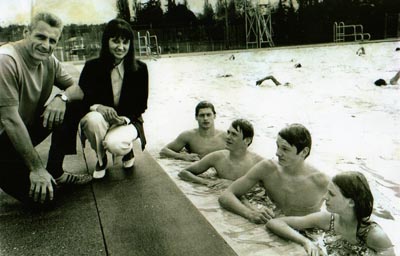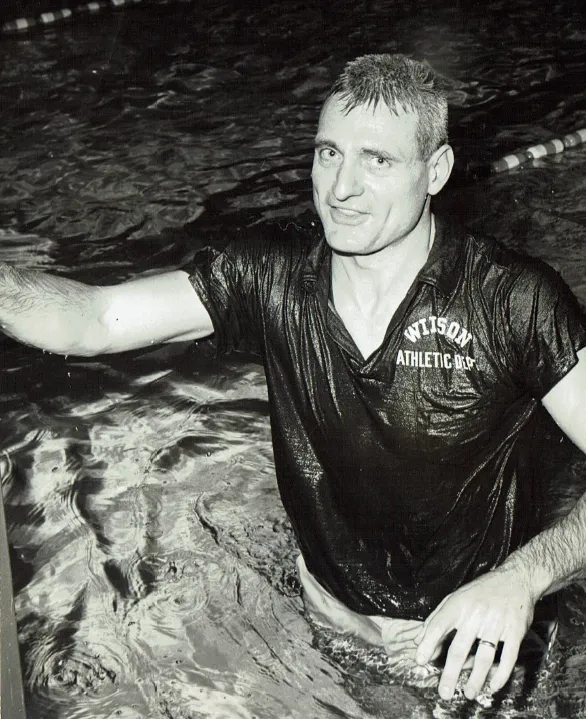Dick Hannula is arguably one of the most successful swim coaches of all time. Under his leadership the Tacoma Swim Club won 24 consecutive state championships, a total of 323 swim meets with no loss!!! He was the US National Swim Coach multiple times between 1973 and 1985, as well as manager for both summer Olympics in 1984 & 1988. He has been inducted into the International Swimming Hall of Fame and is credited with developing the modern swim paddle with holes in them to facilitate feel for the water. He has authored Coaching Swimming Successfully and edited The Swim Coaching Bible.
This is the next instalment in my series about Periodisation (English spelling with an ‘s’, American spelling is traditionally with a ‘z’) and the methodologies from coaches that guided my early philosophies around periodisation of training seasons and event build ups. Have a read of last weeks article about Julian Goater and what he recommends from in The Art of Running Faster:
When Dick Hannula plans a season he bases it around making a master calendar with the entire competitive schedule listed. As a club coach he would plan a full year with two competitive seasons – a short course, followed by a long course. However he acknowledges that some clubs may need a third season in the fall where they have swimmers peaking for a championship meet in order to qualify for meets later in the year.
Three years out of four the USA Swimming National Championship meet would be the most significant meet for the Tacoma Swim Club and in the fourth year it becomes the Olympic trials. This is what is known as a quadrennial plan leading into each Olympic year.
Ingredients of a Plan
Spread across the Preseason Conditioning, Competitive Season, Postseason Transition and Breaks Dick Hannula has the eight components:
- Dry land cross-training;
- Increases in distance and intensity of the training;
- Basic technique skills;
- Motivational methods necessary for success;
- Amount and frequency of speed work;
- Special drills for starts, turns, finishes and relay exchanges;
- Amount and frequency of race pace and endurance training; and
- Length and requirements of the taper, or peak preparation.
Two Season Yearly Plan
In the US the short-course season runs from mid-September to April lasting about 28-30 weeks. The long-course season follows on from April to mid-August, about 18-20 weeks in duration.
General Endurance
The aim of this phase is to develop overall aerobic and fitness levels and lasts for ten weeks. The emphasis is on EN1 (this pace is defined in an earlier article: https://www.coachray.nz/2021/11/15/jill-sterkels-periodisation-for-swimmers/) kicking and stroke drills. Further training in Individual medley and with resistance equipment such as parachutes and buckets.
After 4 weeks training Threshold training is gradually introduced to build to about 20% of total training over six weeks. Sprint training is also included daily but is very minimal totally no more than 5% of weekly volume. About 20% of the weekly total is done through pulling with tubes at EN1 and is also included daily.
Dick Hannula also gets his swimmers to include 30-40 minutes of running, three times per week for the first six weeks during the General Endurance phase of training.
Specific Endurance
Being eight weeks in duration Specific Endurance is the next phase of training. The goal of which is to improve aerobic endurance and maximise the anaerobic threshold, with the emphasis being in the swimmers specialty events. During this phase the weekly volume builds to a peak in the final weeks of the phase. This will typically coincide with holidays for High School athletes during the short-course season build up.
After this overload peak, training levels are dropped back to the levels prior to the overload but intensity is increased. This will create supercompensation which is well placed to lead into the anaerobic phase.
About 25% of this phase is made up of Threshold swimming (except during the overload phase where it is reduced to 15%). Speed training is gradually increased up to about 10% of training volume. Middle-distance and sprint swimmers will do about 10% less total volume than the distance swimmers.
Anaerobic and Competition Phase
Lasting six to eight weeks the goal of this phase is to develop speed with a focus on race-pace whilst maintaining aerobic fitness. For sprint and middle-distance swimmers this phase of training will see a shift to an anaerobic emphasis and for distance swimmers the focus is on race-pace and threshold swimming. Sprinting is increased for swimmers specialising in events shorter than 200m.
Weekly milage is decreased through this phase and the first of the swim meets occur during this phase as well.
Rest and Peak Preparation
This phase will typically last two to four weeks. The goal is to permit adaptation for peak performance. Volume and intensity are decreased. I personally disagree with decreasing intensity at this point in a season, I would maintain the intensity whilst decreasing the volume
Long Course Build Up
This will see shortened phases for General and Specific Endurance, both lasting six weeks each.
Summary
When a season is planed Dick Hannula periodises it through a number of phases to develop his swimmers to their peak ability. Stepping their training up building their volume as he progresses their aerobic fitness. Building to a peak in the Specific Endurance phase he then tapers off the volume whilst adding in more intensity in the final run through into the major meets of the season. This then gets repeated for the Long-Course season all be it with shorter phases due to less tie being available.
Over the course of a distinguished coaching career, Dick Hannula led his high school teams to 24 consecutive state championships, was a two-time president of the American Swim Coaches Association, and is a member of the International Swimming Hall of Fame. Hannula shares more than 50 years of coaching experience and knowledge in Coaching Swimming Successfully.
With input from successful U.S. and international coaches, Hannula presents the latest stroke improvements for greater efficiency and speed as well as new instruction on underwater dolphin kicking techniques. Full practice plans help coaches accomplish more in each training session.
Veteran and beginning coaches will learn how to motivate swimmers, become better communicators, and be prepared for the challenges of competitive meets. Hannula reveals his personal coaching philosophy and helps coaches develop their own code of ethics as they build a winning swimming program in and out of the pool. Detailed advice on how to evaluate swimmers’ performances in practice and in competition, as well as the entire swim program, makes this the complete guide to coaching the sport.
No matter where you coach, Coaching Swimming Successfully will be the guide you refer to season after season.

